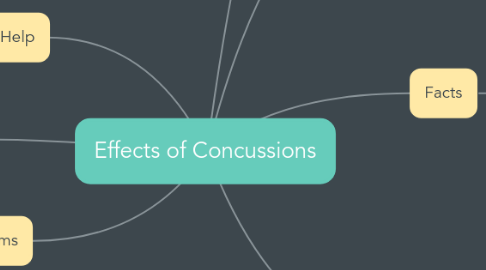Effects of Concussions
by Alex Armata

1. Medical Help
1.1. Some doctors will do a CT scan of the brain
1.2. Other tests, known as “neuropsychological” or “neurocognitive” tests will assess your learning and memory skills, your ability to pay attention or concentrate, and how quickly you can think and solve problems.
2. Signs
2.1. One pupil larger than the other.
2.2. Drowsiness or inability to wake up.
2.3. A headache that gets worse and does not go away.
2.4. Slurred speech, weakness, numbness, or decreased coordination.
2.5. Repeated vomiting or nausea, convulsions or seizures (shaking or twitching).
2.6. Unusual behavior, increased confusion, restlessness, or agitation.
2.7. Loss of consciousness (passed out/knocked out). Even a brief loss of consciousness should be taken seriously.
3. Symptoms
3.1. Remembering and Thinking - Difficulty thinking clearly - Feeling slowed down - Difficulty concentrating - Difficulty remembering new information
3.2. Physical - Headache - Nausea or vomiting (early on) - Balance problems - Dizziness - Fuzzy or blurry vision - Feeling tired, having no energy - Sensitivity to noise or light
3.3. Emotional/Mood - Irritability - Sadness - More emotional - Nervousness or anxiety
3.4. Sleep Disturbance - Sleeping more than usual - Sleeping less than usual - Trouble falling asleep
4. What is it?
4.1. A sudden movement can cause the brain to bounce around or twist in the skull, creating chemical changes in the brain and sometimes stretching and damaging brain cells
5. Recovery Time
5.1. Some symptoms can last for days, weeks, or longer.
5.2. The recovery time is slower for older people
5.3. People who have had a concussion in the past may find that it takes longer to recover from their current injury.
6. Facts
6.1. More than 300,000 sports-related concussions occur annually in the U.S
6.2. Playing a contact sport is estimated to be as high as 19 percent per year of play
6.3. More than 62,000 concussions are sustained each year in high school contact sports and, among college football players, 34 percent have had one concussion and 20 percent have endured multiple concussions
7. History
7.1. Bennet Ifeakandu Omalu is a Nigerian-American physician, forensic pathologist, and neuropathologist who was the first to discover and publish findings of chronic traumatic encephalopathy (CTE) in American football players while working at the Allegheny County coroner's office in Pittsburgh


